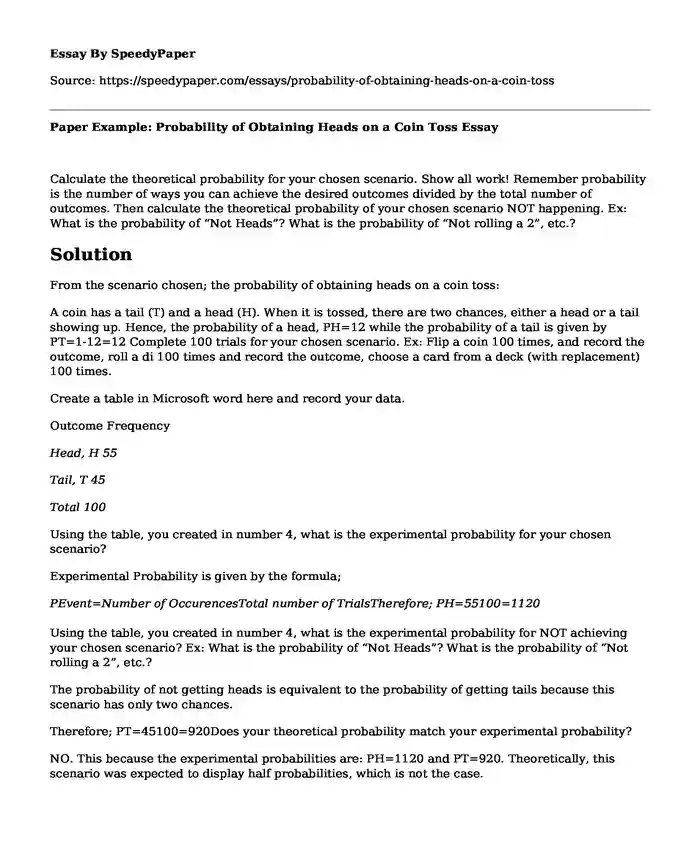
| Essay type: | Quantitative research papers |
| Categories: | Knowledge Data analysis Mathematics Essays by wordcount |
| Pages: | 3 |
| Wordcount: | 689 words |
Calculate the theoretical probability for your chosen scenario. Show all work! Remember probability is the number of ways you can achieve the desired outcomes divided by the total number of outcomes. Then calculate the theoretical probability of your chosen scenario NOT happening. Ex: What is the probability of “Not Heads”? What is the probability of “Not rolling a 2”, etc.?
Solution
From the scenario chosen; the probability of obtaining heads on a coin toss:
A coin has a tail (T) and a head (H). When it is tossed, there are two chances, either a head or a tail showing up. Hence, the probability of a head, PH=12 while the probability of a tail is given by PT=1-12=12 Complete 100 trials for your chosen scenario. Ex: Flip a coin 100 times, and record the outcome, roll a di 100 times and record the outcome, choose a card from a deck (with replacement) 100 times.
Create a table in Microsoft word here and record your data.
Outcome Frequency
Head, H 55
Tail, T 45
Total 100
Using the table, you created in number 4, what is the experimental probability for your chosen scenario?
Experimental Probability is given by the formula;
PEvent=Number of OccurencesTotal number of TrialsTherefore; PH=55100=1120
Using the table, you created in number 4, what is the experimental probability for NOT achieving your chosen scenario? Ex: What is the probability of “Not Heads”? What is the probability of “Not rolling a 2”, etc.?
The probability of not getting heads is equivalent to the probability of getting tails because this scenario has only two chances.
Therefore; PT=45100=920Does your theoretical probability match your experimental probability?
NO. This because the experimental probabilities are: PH=1120 and PT=920. Theoretically, this scenario was expected to display half probabilities, which is not the case.
Complete research on WHY your probabilities might not match or why they might match. *Be sure to cite your source*
The experimental probability and theoretical probability displayed two different results. Conceptually, the theoretical probability is what is predicted to occur in the case of event occurrence (Prodromou, 2012). Basically, it is based on the ideal conditions, which is not always the case. This probability also works under a generalized assumption of the whole event. Hence, this appears to be a whole view of the expected occurrence if the event takes place once. In the experiment of tossing a coin, a good coin is made of two sides, a tail, and a head. It is projected that any single tossing would yield either a head or a tail, which is true because either of the can occur. If the number of tosses is increased on the same coin, the frequency of obtaining the heads and tails changes notwithstanding either a head or a tail on each individual toss. This is because the tossing outcomes are not modified in any way; hence the side showing up appears based on the favorable face on each toss. Notably, the probability of getting tails and heads in either approach remains similar, i.e., the number of possible outcomes divided by the number of trials.
Using the concepts learned this week, what do you think would happen if you did 1,000 trials? *Be sure to cite your reading*
The results of the experimental probability are usually different from the ones obtained from the theoretical probability. In order to minimize the differences in the results therein, there is always a need to increase the number of trials used in the probability (Kelly, 2000). Hence, the determined probability of many trials is closer to the theoretical probability. Generally, increasing the number of trials improves the actual probability of a given event under investigation. However, it is possible to perform an infinite number of trials because of the limiting time and resources. This implies that the probability obtained is the estimated probability of the true probability. The true probability is always computed as the theoretical probability and remains to be that which is expected should a single event occur.
References
Kelly, B. (2000). Statistics & probability with the TI-89. Burlington, Ont: B. Kelly Pub.
Prodromou, T. (2012). Connecting experimental probability and theoretical probability. ZDM, 44(7), 855-868.
Cite this page
Paper Example: Probability of Obtaining Heads on a Coin Toss. (2023, Oct 11). Retrieved from https://speedypaper.net/essays/probability-of-obtaining-heads-on-a-coin-toss
Request Removal
If you are the original author of this essay and no longer wish to have it published on the SpeedyPaper website, please click below to request its removal:
- Marketing Essay Example: Local Source Group Marketing Plan Sample
- Essay Example on the 1993 World Trade Center Terror Campaign
- A Philosophical Discourse Essay, Free Example
- Free Essay with the Strategic Analysis of Polaris Industries
- Literary Essay Sample on Hamlet Play
- Essay Sample on America's Fake News on Political or Social Issue
- Essay Sample on The History of Tennessee State
Popular categories




